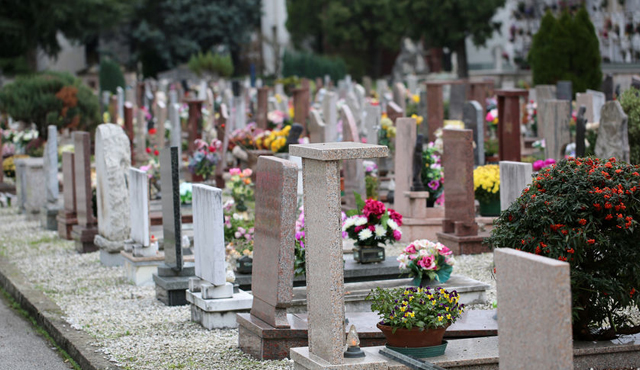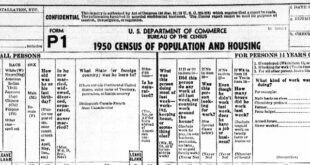I trust you’re all familiar with children’s book series, “Where’s Waldo,” in which kids are tasked with finding the titular character, who’s hiding in an enormous crowd. I have spent the better part of the past two months playing a genealogical game called “Where’s Waldo Buried?”
It’s easy to keep track of the relatives you see frequently or you stay in touch with through social media. However, the relatives in your tree who you’ve never met and haven’t “friended” are another matter. These people may be distant relatives but you do not know them and they do not inform you when one of their number passes away.
A couple of years ago, I wrote a column about using newspapers to find death notices, and I need to amend this already. The world of death notices and funerals is changing and it affects how we find out where Uncle Waldo is buried … or is he?
Things were more predictable in the old days. Wakes might run 2-3 days, or at least 3 p.m.-9 p.m. the night before the funeral mass. Everybody was buried in the family lot at the cemetery that was predominantly Italian. Nowadays, things are very different. Wakes may be only for an hour before the service. The family is scattered all over Chicagoland and elsewhere, so they are not buried in the usual cemeteries. In many cases, there is no wake or funeral or even burial. The newspaper notice is not there to tell you when and where to attend a wake, but rather it is there a month or two after the death, to tell you when and where to attend the Celebration of Life. It has also become more frequent that people do not post a newspaper death notice, but only post on the funeral home web site.
As genealogists, we are not looking for these notices to attend the services. We are, however, looking for clues from that notice that will help us get more information.
So, logistically, how do we find out that someone has died? If they don’t notify us, how do we check? Well, we have to initiate the search, since we don’t have any cousins who will let us know. Where do we look, to make sure we find it?
My first place to look is www.legacy.com. This site is not a comprehensive lookup of every newspaper, but does cover a lot of major papers, in Chicagoland and out.
The main search page allows you to look for a first and last name, and limit the search to a period of time (last 30 days is the default) and a location (pick your US state, or search all). I usually click on “keyword search” so I have more options. Instead of “past 30 days”, I can select “All Time”. This does not mean that it goes back to 1749! Most papers are in this site since about 2002 or so. Then I enter the last name. In order to narrow down the search, I will enter the wife’s maiden surname in the “Keyword” field. If I don’t know the wife’s maiden surname, I enter the first names of both the husband and wife in the “Keyword” field.
Last Name: Johnson Keyword: Andreoni or
Last Name: Johnson Keyword: Waldo Deborah
This type of search will find either the husband or the wife if either, or both, passed away. It might also find an unmarried/divorced sibling, all by using one search.
As noted earlier, a lot of people are no longer posting a death notice in the newspapers. They create a memorial page on the funeral home web site. The good news is that many such pages have both the birth date and death date, which is usually not true for newspaper death notices. They also get into a lot more detail, because it doesn’t cost as much as a newspaper notice, which is charged by the word.
Most of us do not know which funeral home a family used, so you can’t just start checking every funeral home web site in town to see if someone’s there. It is much easier to search google. I usually enter a search in Google “waldo Johnson Deborah andreoni” to see if anyone in the Waldo Johnson family died, assuming he was married to Debbie Andreoni. I usually enter the more formal first names of people. Maybe everyone called her Debbie, but it’s more likely that they used her formal name if she died, so it’s best to search for Deborah.
I search for both full names in order to narrow the search results. My search will also find if Waldo Andreoni died or his wife Deborah Johnson too, or Deborah Waldo. Any combination of names will appear. Another tip is to add the word “beloved” to the search, which is a word used in death notices very frequently. If you choose to leave out “beloved”, you might get a lot of other search results for this family that will not help you find a notice.
If your family names are common, you might have a bigger problem finding them. This is also true of the family name happens to be a local funeral home, because they appear in a lot of people’s notices. I am related to the Carbonara family and the Rago family as well, and so when I search for Pietro Carbonara, I end up finding a lot of people named Pietro who were waked or buried through Carbonara Funeral Home.
Having gone through all this trouble to check for a notice, you may not find the big mystery, where Waldo is buried. A very large percentage of the notices I find in the past ten years either says “Burial private” or does not mention the burial at all. I cannot speak to the reasons for this. There does seem to be a much smaller percentage of gatherings at the graveside and watching the casket lowered into the ground. It just seems more likely that the immediate family only gathers at a graveside or chapel, or not at all. Perhaps it is due to cost, but a lot of people are choosing cremation rather than burial, and once they cremate, they can keep the ashes at home, scatter them, or put the ashes in a niche at a cemetery. Once a family cremates someone, they can wait a year to hold a service if they want to, so your notice may have nothing to do with the date of death. At least if someone is buried, it’s usually a few days removed from the date of death, at most. Due to this shift in end-of-life practices, there are fewer and fewer notices that tell those of us who research where Waldo is buried.
A few people have asked me about contacting the funeral homes themselves to find out what they did with Waldo. My experience has been that if the funeral was private, they typically do not release that information later on. I also know that funeral homes are very busy with details to deal with on their current funerals, and they really don’t have a lot of time for genealogy requests. My advice would be to write them a polite letter asking for the location of the deceased and let them know they can take their time about it. This might make them more likely to help at all. I do not recommend calling funeral homes looking for information.
When looking for notices, try to find the funeral home memorial page, or find the most local newspaper (in other words, look for a Daily Herald before looking for the Tribune). The reason for this is that they usually list more details, especially the names of the surviving descendants. Due to cost, the tribune or Sun Times notice might say “grandfather of twelve” with no names, or it might say “grandfather of Joey Primo, Vinny, Maria, Minnie, Joey North Side, Jimmy-boy, Joey South Side, and baby Joe.” Which is usually the list of grandkids by age, but no mention of which family they belong to. I have found that a funeral home memorial page or longer death notice in a smaller paper will sometimes group the kids together by family and mention surnames, which helps link them to the right family. Example: “father of Nick (Anna), Margaret (Fred Campobasso), Beppe and Virginia (Bill Kaminsky). Grandfather of Joey Primo, Maria and Jimmy-boy Johnson; Joey South Side, and Vinny Campobasso; Minnie and Joey North Side Johnson; and baby Joe Kaminsky.” I hope you see what I mean here. My advice is to look for the Trib but also check the others as they might be different or more detailed.
Once in a while, you are looking for Waldo and you find in the notice that he was predeceased by “his parents Giuseppe and Maria, and his sister Filomena Yarnall. There’s a surprise. Had no idea Minnie was gone too. Watch for these and do your next search. If there is no notice for Filomena Yarnall, you can at least mark your family tree file that she died before the date that Waldo died.
After you find a few “Waldos” in these notices, you can try to track down the cemetery by checking the Archdiocese of Chicago Catholic Cemetery kiosk. Even if the burial was private, you might find the cemetery and grave location in the kiosk.
There is no guaranteed one-stop-shop to find a definitive answer that confirms whether Waldo is alive or deceased. Try these techniques and see if they help. Write to italianroots@comcast.net and put “Fra Noi” in the subject if you have any questions.
 Fra Noi Embrace Your Inner Italian
Fra Noi Embrace Your Inner Italian






